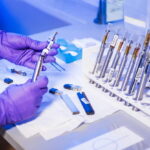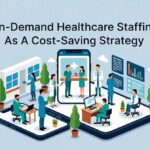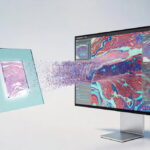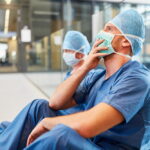Balancing security and access in any property is always a fine line to tread. However, healthcare facilities have unique challenges that make balancing these twin demands much more difficult.
First and foremost, there is the security of patients, visitors and staff to consider. Then there are the physical assets that need to be protected. Additionally, all this needs to be done in an often hectic environment with multiple public access entry points that remain open 24/7.
In this guide, we look at these challenges and the groundbreaking solutions that are helping healthcare facilities balance access and security.
Unique Security Challenges in Healthcare
Integrating security into healthcare construction is far from straightforward. These projects are complex, with specific challenges that require careful consideration, including security.
We consider the solutions that can address the security challenges a little later. However, a critical first step is always to “grasp the complexities.” Below we look at some of the main “security v. access” challenges in healthcare facility design:
– 24/7 operations: Healthcare facilities operate around the clock, necessitating constant security vigilance.
– Multiple access points: With various entry and exit points for patients, staff, and visitors, controlling access is a significant challenge.
– Public accessibility: As public spaces, hospitals must balance being welcoming while safeguarding against potential threats.
– Protection of sensitive areas: Areas like pharmacies, records rooms, and intensive care units require heightened security measures.
– Safety of patients, staff, and visitors: Ensuring the physical safety of everyone on the premises is paramount.
– Asset protection: Healthcare facilities house expensive equipment and medications that need safeguarding from theft or misuse.
– Data security: With vast amounts of sensitive patient data, cybersecurity is a critical aspect of overall security.
The mix of vulnerable patients, threats of violence, drug and equipment theft, and an open-door policy make securing healthcare facilities a challenging task. But not, as we discuss next, an impossible one.
Comprehensive Security Measures for Healthcare Facilities
The complexities of balancing security and access is only part of the story. The clinic atmosphere and design also matters to patients and effective solutions must offer security while maintaining a comfortable, secure, and welcoming environment.
Let’s look at some of the advanced (and traditional) solutions enabling this:
Camera Surveillance Systems
Cutting-edge camera surveillance in healthcare security systems fit into both the advanced and traditional categories. These have played a major role in healthcare facilities for decades. However, modern systems offer the usual blend of deterrence and detection but also add other key benefits, including:
– Real-time monitoring: Gone are the days of grainy black-and-white footage, Modern systems enable continuous observation of critical areas in full HD.
– Advanced AI analytics: AI-driven analytics can identify unusual patterns or behaviors, aiding in preemptive security measures.
– Evidence collection: Provides valuable footage that can be used for investigations and legal proceedings.
– Remote accessibility: Allows security personnel to monitor multiple locations simultaneously from a central point.
Robust security for healthcare begins with a knowledge of what is going on. Advanced surveillance systems are the backbone that provides this.
Advanced Access Control Systems
Access control is one of the most fundamental challenges for healthcare facilities. It is here where the real “access v. security?” question truly comes to the foreground. Just how do you regulate and restrict access to healthcare facilities, while balancing the two demands?
Modern access control systems are opening all the right doors to enable this:
– Customizable access: Tailor access permissions for different staff levels, areas, and times.
– Integration with other systems: Seamlessly works with surveillance and alarm systems for comprehensive security.
– Visitor management: Efficiently tracks and manages visitor access, enhancing overall security.
– Audit trails: Provides a record of who accessed which areas and when – crucial for investigations.
These systems are changing the meaning of “keeping it under lock and key” offering sophisticated solutions that ensure security without compromising the accessibility essential in healthcare settings.
Integrated Emergency Response Systems
Integrated emergency response systems are crucial in healthcare facilities striking a balance between unrestricted access and robust security. These systems ensure swift and coordinated responses during emergencies.
Implementing such systems offers immediate benefits that include:
– Rapid response coordination: Enables quick mobilization of emergency protocols, ensuring immediate action.
– Integration with security infrastructure: Works in tandem with surveillance and access control systems for a cohesive security approach.
– Clear communication channels: Facilitates effective communication among staff, security, and emergency responders.
– Automated alerts and lockdowns: Again, this can be integrated with access control and surveillance systems to automatically initiate lockdowns or alerts in response to identified threats.
These integrated systems demonstrate how healthcare facilities can maintain open access while being fully prepared for any security emergencies, ensuring both safety and accessibility.
Health and Safety: Harmonizing Access and Security in Healthcare
The unique demands of allowing access without compromising security in healthcare facilities might, at first glance, seem like an impossible ask. How can you operate an open-door policy and maintain security?
The answer lies not with one magic solution, rather it is a blend of integrated technologies where the whole is greater than the sum of its parts. By leveraging such an approach, it is possible for healthcare facilities to maintain an open-access, welcoming, and – above all – secure environment.
Read Also
- Creative Approaches to Alleviating Healthcare Staff ShortagesHospitals and clinics are facing staff shortages, which makes it harder to take care of patients well. Finding simple and useful solutions is very important. Easy changes like flexible work hours, good training, and chances to grow can help staff stay happy. Technology, like online doctor visits and helpful tools, can make work easier. Smart… Read more: Creative Approaches to Alleviating Healthcare Staff Shortages
- Understanding the Role of Sterilizers in Healthcare FacilitiesHave you ever wondered how hospitals keep their equipment safe enough to use on dozens of patients every day? Most people never think about what happens behind the scenes, yet these hidden steps play a huge role in patient safety. Sterilizers are part of that system, working quietly to remove harmful germs before any instrument… Read more: Understanding the Role of Sterilizers in Healthcare Facilities
- Building Healthcare Access Where It’s Needed Most: A Local First ApproachHealthcare shouldn’t depend on where you live. But in the U.S., it often does. If you’re in a big city, you likely have options. If you’re in a small town or an underserved neighbourhood, it’s a different story. To fix this, more healthcare leaders are turning to a local-first approach. That means putting clinics and… Read more: Building Healthcare Access Where It’s Needed Most: A Local First Approach
- Revolutionizing Patient Engagement: Innovative Solutions for Improved Care and Treatment SuccessNavigating healthcare system can often feel overwhelming for patients. Between appointments, prescriptions, and treatment regimens, it’s easy for crucial details to get lost in the shuffle. That’s why effective patient engagement and support solutions are more important than ever. Companies like Serva Health, with their pharma hub services, are stepping up to ensure that patients… Read more: Revolutionizing Patient Engagement: Innovative Solutions for Improved Care and Treatment Success
- On-Demand Healthcare Staffing As A Cost-Saving StrategyThis is an exciting and challenging time for the healthcare industry. Technology is advancing almost faster than humans can keep pace. New legislation is creating fresh challenges for the future of healthcare, and the shifting population demographic continues to place more pressure on healthcare facilities. Amidst these changes, healthcare facilities are facing a critical staffing… Read more: On-Demand Healthcare Staffing As A Cost-Saving Strategy
- Automated Healthcare Software Solutions: How Intelligent Platforms Are Redefining Clinical, Administrative, and Operational ExcellenceThe healthcare industry is undergoing a seismic transformation. Rising patient volumes, value-based care models, staffing shortages, and complex regulatory demands have prompted organizations to look beyond traditional tools and embrace advanced software automation. As providers search for innovative partners capable of tailoring these sophisticated systems to real-world workflows, many turn to MCSI (Managed Care Systems,… Read more: Automated Healthcare Software Solutions: How Intelligent Platforms Are Redefining Clinical, Administrative, and Operational Excellence
- The Benefits of Contract Labor Staffing in HealthcareThe most successful healthcare facilities today aren’t just reacting to crises—they are building workforce resilience to withstand them. Unpredictable patient demand, coupled with persistent nursing shortages, has made the traditional staffing model obsolete. Relying on mandatory overtime to cover a sudden surge in capacity is a recipe for high turnover and rising employee burnout relief… Read more: The Benefits of Contract Labor Staffing in Healthcare
- Why Whole Slide Imaging Shapes the Future of Digital PathologyWhole slide imaging has become one of the most important developments in modern pathology. It changes how tissue is examined, how cases are shared and how pathologists collaborate with the wider care team. More than a technological upgrade, it represents a shift in how laboratories think about their workflow, their storage needs and the tools… Read more: Why Whole Slide Imaging Shapes the Future of Digital Pathology
- Management Reinforcement for Healthcare Providers in a Shifting SystemHealthcare is changing faster than ever. So, providers are feeling the pressure to keep up. New technology, changing patient needs, and constant rule updates make it tough for managers to stay on top. Strong leadership helps teams work better, give great care, and stay happy in their jobs. Here’s how healthcare leaders can strengthen their… Read more: Management Reinforcement for Healthcare Providers in a Shifting System










